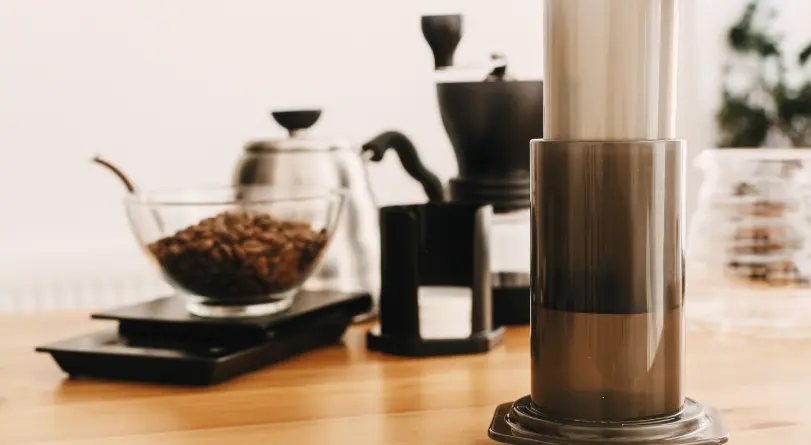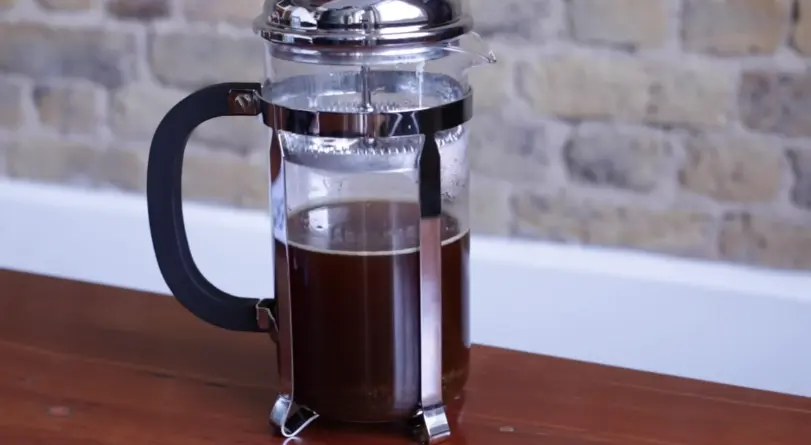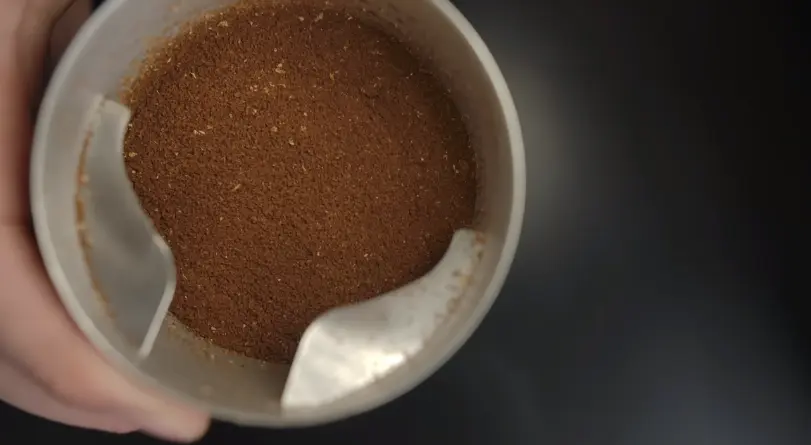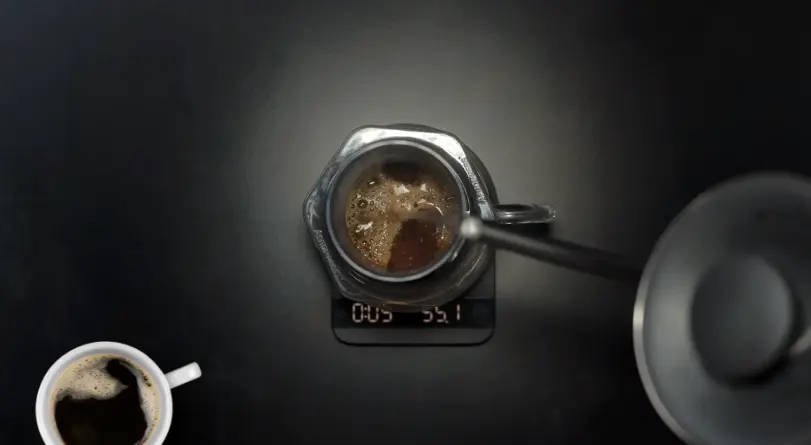Both Aeropress and the French Press are popular among coffee lovers. Both have their own preparation techniques and result in different flavors and textures.
In this article, we will compare the Aeropress and the French Press to determine which method is better for brewing coffee. Let us dive into the debate of Aeropress vs French Press!
Aeropress overview:
The Aeropress is a device that uses pressurized air to extract the flavor of ground coffee. It consists of two cylinders, one that fits inside the other, with a plunger at the top. To brew coffee, a filter is inserted into the bottom of the appliance, coffee and hot water are added, stirred, then the plunger is pushed down to force out the brewed coffee.

Pros and Cons of Aeropress:
Advantages of Aeropress:
- Quick and easy to use: The Aeropress only takes minutes to brew a cup of coffee, and the process is straightforward and easy.
- Consistent quality: The Aeropress produces a good cup of coffee with a clean, smooth taste.
- Easy to clean: The Aeropress is easy to clean, since all its parts are easily removable and dishwasher safe.
- Portable: The Aeropress is lightweight and portable, making it perfect for travel or outdoor activities.
Disadvantages of Aeropress:
- Single Serve Only: The Aeropress is only capable of brewing a single cup of coffee at a time.
- Limited capacity: Aeropress can only hold a limited amount of coffee and water, so it is not suitable for preparing large quantities.
- Paper Filters Required: The Aeropress requires paper filters, which can be an added expense and inconvenience.
- Fragile: The Aeropress is made of plastic, so it can break if mishandled.

Overview of the French press:
The French press, on the other hand, is a simple device that uses a metal mesh filter and a plunger to separate the coffee grounds. Ground coffee and hot water are added to the press, stirred, allowed to settle for a few minutes, and then the plunger is pressed to separate the coffee grounds.
French press coffee maker pros and cons:
Advantages of French Press coffee maker:
- Intense Flavor: The French press produces an intense, full-bodied flavor that many L coffee lovers prefer.
- Large Capacity: The French Press Coffee Maker can brew large amounts of coffee, making it suitable for sharing or serving a crowd.
- Reusable Metal Filter: The French press does not need paper filters, making it more environmentally friendly and cost-effective in the long run.
- Durable: The French press is usually made of glass or stainless steel, making it more durable than the Aeropress.
Disadvantages of French Press coffee maker:
- Long brew time: The French press requires a longer brew time than the AeroPress, which can lead to over-extraction and a bitter taste.
- Inconsistent quality: The French press can produce an inconsistent cup of coffee, with some batches being too weak or too strong.
- More difficult to clean: The French press can be more difficult to clean, as the metal mesh filter requires special attention to remove all coffee residue.
- Heavy and bulky: The French press is heavy and bulky, making it less portable and more difficult to store than the Aeropress.

Difference between Aeropress and French Press
1. Preparation method:
The Aeropress and French Press coffee makers differ in their preparation method. The Aeropress uses a unique method of applying air pressure to force water through the coffee grounds. Instead, the French press uses a metal mesh filter to separate the coffee grounds.
The Aeropress is designed to prepare coffee quickly, producing a cup of coffee in just a few minutes. The coffee produced by the Aeropress has a smooth and clean flavor. The French press, by contrast, is designed for a slower brewing process that allows for a longer steeping time, resulting in a fuller-bodied coffee with a more intense flavor.
2. Grind size:
The Aeropress requires a fine to medium grind size, similar in texture to table salt. This grind size allows for fast, even extraction, producing a bright, clean cup of coffee with a smooth texture.
The French press requires a coarser grind size, similar to coarse sea salt. This grind size allows for slower, longer extraction, resulting in a stronger, bolder coffee with an earthier flavor and fuller body.
3. Coffee flavor: Difference between Aeropress and French press
One of the main differences between the Aeropress and the French press is the flavor of the coffee they produce. The Aeropress is known for producing a clean, smooth flavor, while the French Press produces a rich, full-bodied flavor.
The Aeropress uses a paper filter, which removes any coffee sediment or grounds, resulting in a clean, clear cup of coffee. The French press, by contrast, uses a metal mesh filter that allows coffee grounds and oils to pass through, resulting in a full-bodied, rich flavor.
4. Coffee preparation time:
The Aeropress and the French press also differ in preparation time. The Aeropress is designed for fast and efficient preparation, producing a cup of coffee in just a few minutes. The French press, on the other hand, requires a longer infusion time, usually around four minutes.
The longer brew time of the French press allows for a more complete extraction of flavor from the coffee grounds. However, the Aeropress makes up for its short brewing time with its unique brewing method that produces a clean, smooth cup of coffee.

5. Coffee preparation capacity: AeroPress vs French Press
The Aeropress and the French press differ in their brewing capabilities. The Aeropress is designed to brew a single cup of coffee at a time, while the French press can brew larger amounts of coffee.
The Aeropress is perfect for those who prefer to make a single cup of coffee at a time, while the French Press is ideal for those who need to prepare large quantities of coffee for several people.
6. Ease of cleaning: French Press and Aeropress
The Aeropress and the French Press differ in their ease of cleaning. The Aeropress is designed with removable parts that are easy to clean and dishwasher safe. The French press, on the other hand, can be more difficult to clean, especially the metal mesh filter.
To clean the French press it is necessary to disassemble the filter and remove the coffee grounds that have gotten stuck in the mesh. The Aeropress is easier to clean, requiring only a quick rinse and run through the dishwasher.
7. The filter type: French press vs. the Aeropress:
The French press uses a metal mesh filter that is placed over the plunger. The filter allows oils and coffee solids to pass through, resulting in a rich, full-bodied cup of coffee. The wire mesh filter does not remove oils from the coffee, which contribute to its flavor and aroma. However, it can also let through fine sediments, resulting in a slightly gritty texture.
The Aeropress uses a paper or metal filter that is placed in the portafilter. The paper filter removes oils and solids from the coffee, producing a cleaner, brighter cup of coffee. The paper filter also removes any sediment, resulting in a smooth, clear cup of coffee. The metal filter used in the Aeropress allows some of the coffee oils to pass through, resulting in a cup with a bit more body and flavor than the paper filter.
8. Portability of Aeropress and French Press:
The Aeropress and the French press also differ in their portability. The Aeropress is designed to be lightweight and portable, making it easy to travel with. The French press, by contrast, is heavier and bulkier, making it less portable.
The Aeropress is perfect for those who want to make coffee on the go, while the French Press is ideal for home use.
9. Cost difference: Aeropress and French press
The Aeropress and the French Press differ in their cost. The Aeropress is usually cheaper than the French press, but the cost of paper filters can increase over time.
The French press is a more expensive initial investment, but the cost of replacement parts is minimal. The Aeropress is a cheaper initial investment, but the cost of replacement filters can increase over time.
French press or the AeroPress which one is healthier?
The European Journal of Preventive Cardiology published a study in 2020 that concluded that filtered coffee with a paper filter, like the one used in the AeroPress, is better for your health than unfiltered coffee, like the one made with a French press. This is because paper filters effectively remove a substance called cafestol, which is a type of cholesterol found in coffee beans.
Cafestol has been linked to increased levels of LDL (bad) cholesterol, which can contribute to heart disease. Using a paper filter significantly reduces the amount of cafestol in your coffee, making it a healthier option overall.
However, this does not mean that French press coffee is unhealthy. According to the study, French-press coffee is safe as long as you don’t consume more than two cups a day and you don’t have any underlying heart disease. Additionally, French-press coffee contains more beneficial antioxidants than filter coffee, which may have some health benefits.
The AeroPress, for its part, produces a smoother, less oily cup of coffee with lower levels of cafestol. It also requires less coffee and produces less waste than the French press, making it an environmentally friendly option.
Learn how to remove cafestol from your coffee.
Aeropress vs French Press: Which is better for you?
Ultimately, the choice between the Aeropress and the French Press comes down to personal preference and preparation needs. If you prefer a clean, smooth cup of coffee and only need to brew one cup at a time, then the Aeropress may be the best choice.
However, if you prefer a rich, full-bodied flavor and need to brew large batches, a French press coffee maker may be the best option. Both methods have their pros and cons, so it’s important to consider your needs and preferences before making a decision.
Do not miss the list of the best pour-over coffee makers!


